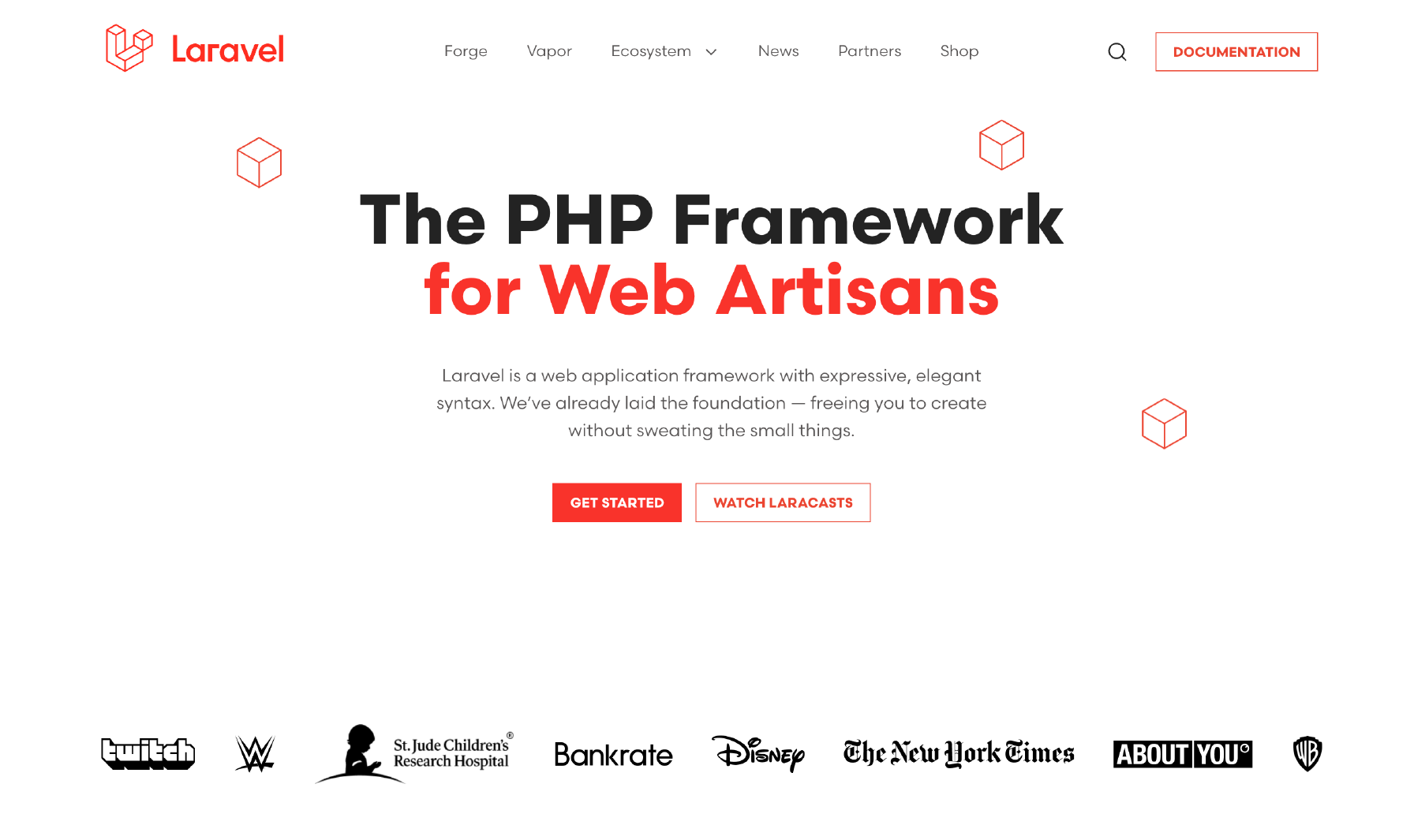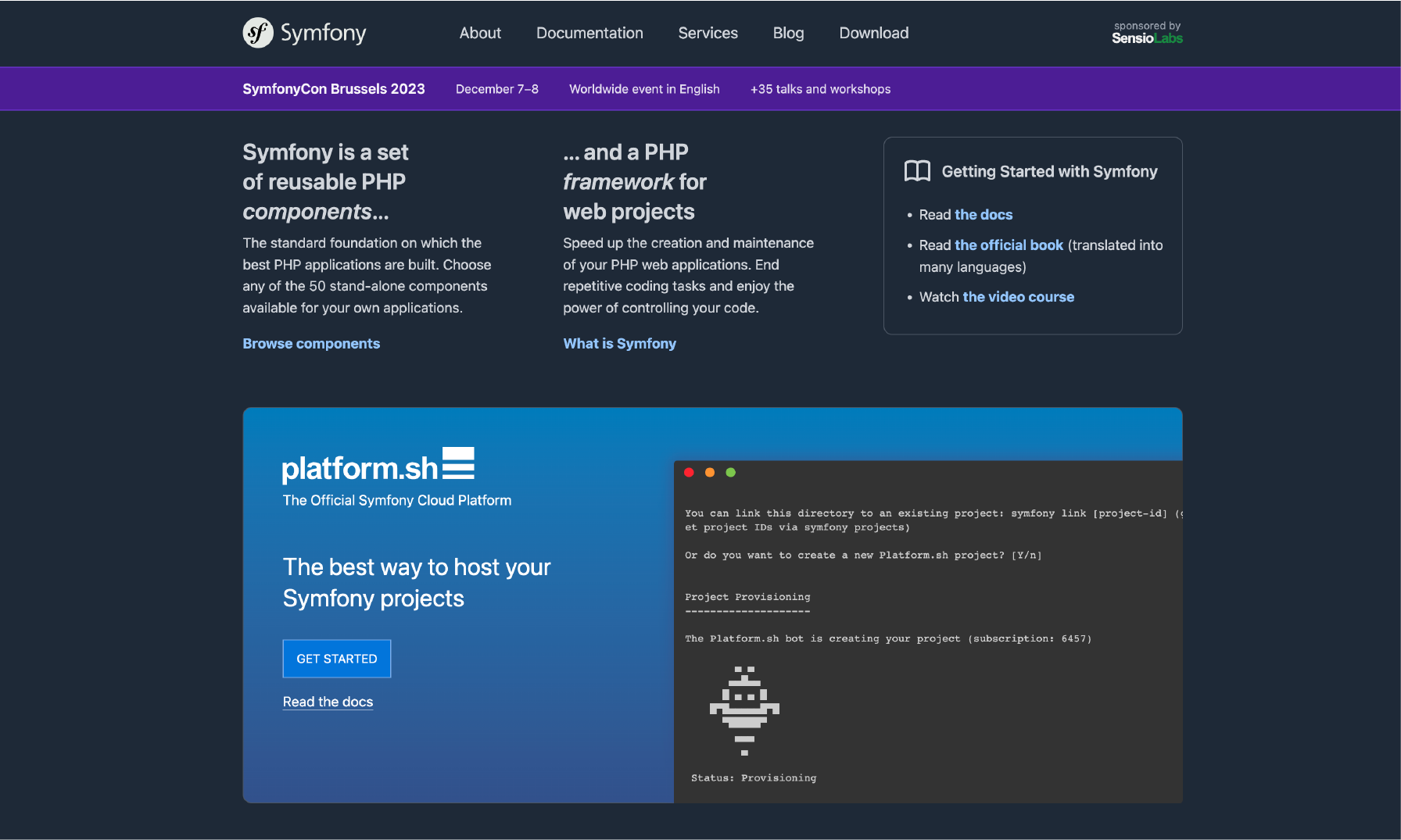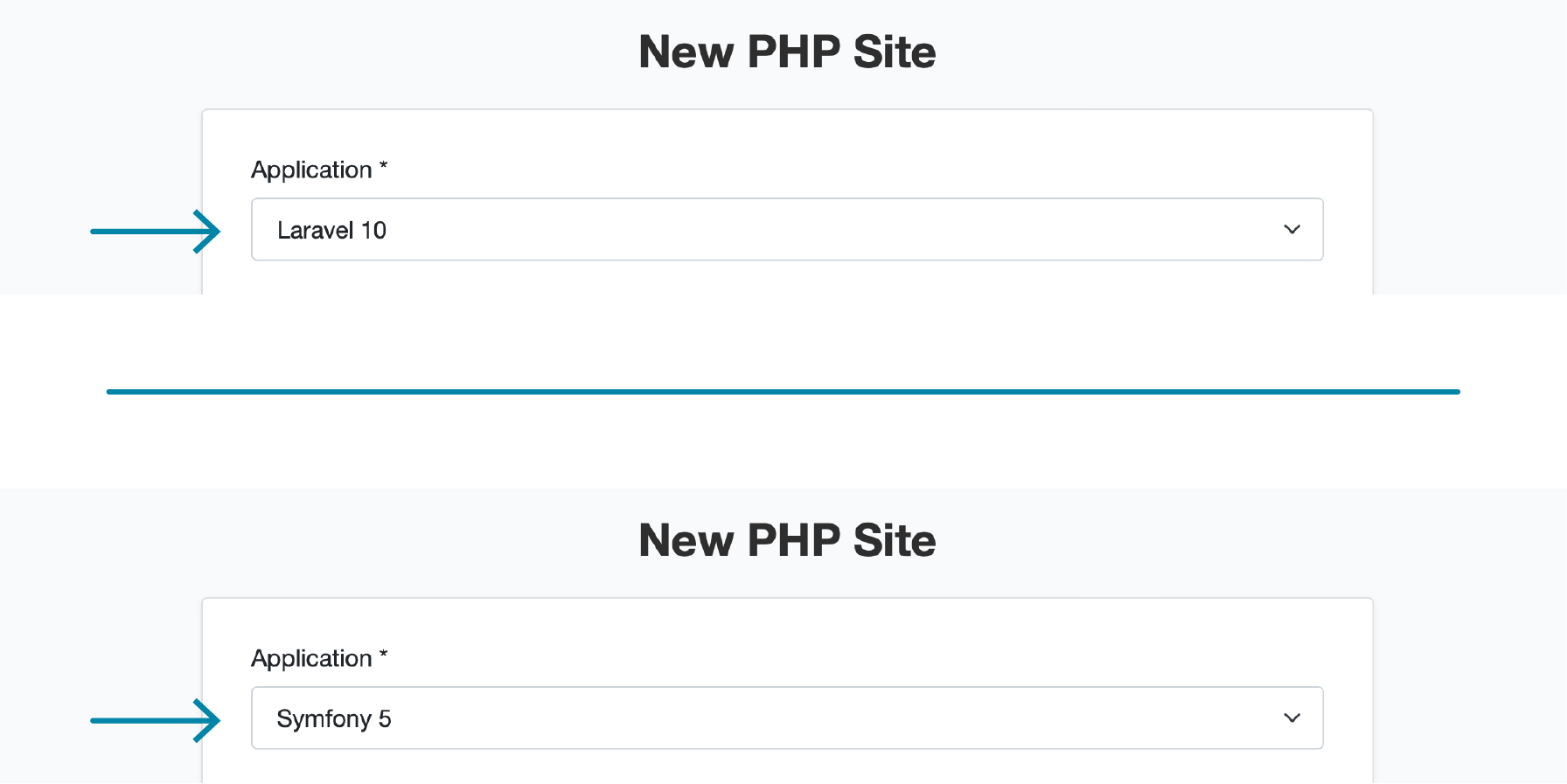
Laravel vs. Symfony: Which PHP Framework to Choose?
Are you choosing between Laravel vs. Symfony for your website? Both Laravel and Symfony are popular PHP frameworks for web development. Let’s see how they stack up against each other. This article will provide an in-depth comparison to help you make the best choice for your project.
Key Takeaways
- Learn the key features and strengths of Laravel and Symfony, two popular PHP frameworks for web development.
- Understand the similarities and differences between Laravel and Symfony. Get details on installation, directory structure, CLI tools, coding style, testing, performance, and more.
- Gain insights into how Laravel and Symfony can meet your specific project needs, considering factors. It includes complexity, customization, and database migration capabilities.
- Consider both frameworks' learning curve and community support to make an informed decision.
- Evaluate the modularity and scalability of Laravel and Symfony in integrating with libraries and handling resources.
- Explore the documentation and extensive support provided by Laravel and Symfony to assist you in utilizing these frameworks effectively.
Laravel Overview

Laravel is an open-source PHP framework known for its elegant syntax and MVC architecture. It offers features like in-built authenticating and password options for improved security, a blade templates engine, and access to the Artisan command-line tool.
Laravel's release of version 10 has spurred its growth. It offers lightweight and automated processes by separating business logic and display code. It incorporates cutting-edge PHP features, third-party API integrations, and automated testing. Laravel’s user-friendly syntax and rapid development process make it accessible to users.
Symfony Overview

Symfony is another PHP framework that speeds up web app development by eliminating repetitive coding. Notable features include Twig templating language, flexible URI routing, and structured MVC.
It's known for offering custom web development solutions for various project types, quick debugging, and easy code configuration. It's known for offering Its reusable components help simplify complex projects, making it a preferred framework for heavy-duty tasks.
Similarities and Differences between Laravel and Symfony
1. Installation
In both Laravel and Symfony, the installation process is straightforward. For a successful installation, Laravel requires PHP 7.2.5 or higher, OpenSSL PHP Extension, PDO PHP Extension, and Mbstring PHP Extension. You install it by using Composer - a tool used for dependency management in PHP. It allows you to declare libraries your project depends on.
Symfony also employs Composer for its installation process but has different requirements: PHP 7.1.3 or higher plus these extensions: Ctype, iconv , JSON, PCRE, Session, SimpleXML, and Tokenizer.
Laravel has more built-in features than Symfony, making its initial download larger. It can sometimes make Laravel a bit slower off the starting blocks than Symfony. With the right PHP versions, required extensions, and global composer setup, installing either framework is easy for developers.
Application Set Up
You can easily set up the Laravel and Symfony 5 applications using CloudPanel in a few clicks.

2. Directory structure
Laravel employs an MVC-based directory structure. It effectively divides a project into three interconnected parts - the model, view, and controller. The layout enhances code maintainability by separating the user interface from business logic. Laravel’s directory structure encourages developers to write cleaner and more readable code.
Symfony follows a bundle-oriented directory structure. Each 'bundle' corresponds to a separate feature or functionality of the application. The unique approach provides flexibility; different functionalities can be packaged into reusable bundles across multiple projects.
When comparing Laravel vs. Symfony on its directory structure, both offer unique advantages on varying project requirements.
3. CLI tool
Laravel and Symfony frameworks provide users with powerful Command Line Interface (CLI) tools. Laravel features Artisan, an in-built command-line tool that helps expedite many repetitive programming tasks. It can generate boilerplate code for new controllers, models, and migrations. It speeds up the development process significantly.
Symfony’s CLI tool is known as Console. It also boasts functionalities like routing debug commands and creating bundles for productivity. The CLI tools aid in performing database migrations smoothly in both frameworks. It is advantageous for developers who maintain an organized workflow without frequently switching contexts. Both CLIs offer possibilities for automation and rapid application development. The choice depends on the project's specific needs and the developer's preference.
4. Coding style
When it comes to coding style, Laravel, and Symfony have their distinct approaches. In Laravel, the coding style is focused on simplicity and readability. It follows a more expressive syntax that allows for an easier understanding of the code.
Symfony emphasizes a more structured, strict coding style that adheres to established best practices. It helps maintain consistency across projects and makes collaborating easier for developers. Both frameworks provide guidelines to ensure clean and maintainable code. It makes it easier for developers to write high-quality applications with reduced errors.
5. Configuration
Laravel and Symfony have different approaches to configuration. In Laravel, the configuration files are stored in the config directory. It allows developers to modify settings like database connections or caching options easily.
Symfony components adopt a more flexible approach by using YAML or XML files for configuration. It allows for greater customization and modularity, as developers can define their custom configurations or override default settings. Both frameworks provide clear documentation on how to configure applications effectively.
6. Template engine
The template engine is an essential component in both Laravel and Symfony frameworks. It separates the presentation layer from the application's business logic. It makes it easier to maintain and update web applications.
In Laravel, the Blade template engine provides a simple yet powerful syntax for creating reusable templates. It has an intuitive syntax and built-in features like extending layouts and including partials. Blade makes it easy to create dynamic web pages efficiently.
Symfony uses Twig as its default template engine. Twig offers a secure sandbox environment that prevents malicious code execution and provides robust caching mechanisms.
7. Testing
With Laravel, you can perform unit tests using PHPUnit, which allows you to test individual components or units of code. It helps identify any bugs or issues early in the development time.
Symfony provides a built-in testing framework called PHPUnit Bridge, making writing and executing tests for your Symfony applications easy.
You can create functional testing that simulate user interactions and integration tests to verify the behavior of multiple components working together. Both frameworks provide testing tools that enable developers to maintain high code quality and performance standards.
8. Performance
Laravel and Symfony offer high-performance PHP frameworks for web application development. They provide built-in tools to enhance performance, such as database query optimization and HTTP cache.
Developers can utilize the power of these frameworks to create fast-loading web applications that deliver a seamless user experience. Laravel and Symfony have active communities that constantly work on improving performance with updates and optimizations.
9. Security
Laravel and Symfony prioritize the security of web applications. They provide various features and tools to ensure secure development and protect against common vulnerabilities. These frameworks offer built-in measures for preventing cross-site scripting (XSS) attacks, SQL injections, CSRF attacks, and more.
You get support for authentication mechanisms. It helps control access to sensitive data or functionalities within the application. Developers can also use encryption libraries provided by these frameworks to safeguard user data during transmission or storage.
10. Global Reach
Both frameworks offer robust support for internationalization. It allows developers to create multilingual web applications easily. They provide language files, translation services, and locale management features.
It enables the development of websites that can adapt to different languages and cultures. With these capabilities, businesses can reach a wider audience and cater to users worldwide.
11. Deployment
Both frameworks offer seamless deployment options, enabling efficient and hassle-free deployment of your projects. With Laravel, you can easily deploy your applications to various cloud platforms or hosting providers. Symfony provides robust deployment capabilities through its built-in tools like Capifony and Deployer. These tools ensure smooth deployment by automating tasks. It includes uploading files, clearing caches, and running migrations.
12. Popularity and Support
Laravel and Symfony are both popular PHP frameworks used by web developers. Laravel has gained significant popularity recently due to its elegant syntax and rapid application development.
Symfony is known for its robustness and flexibility, making it a preferred choice for complex web applications. Both frameworks have active communities, further contributing to their popularity among PHP developers.
13. Documentation
Laravel and Symfony provide extensive and long-term documentation. It includes detailed explanations, code examples, and step-by-step instructions to guide developers in using the frameworks effectively.
The well-organized documentation makes it easy to navigate and find the specific information needed. It covers various topics, including installation procedures, configuration, and template engines. You can check testing methodologies, security practices, performance optimizations, and more.
Key Differences between Laravel and Symfony
| Feature | Laravel | Symfony |
|---|---|---|
| MVC Design Pattern | Follows MVC pattern, favoring modularity. | Offers flexibility with diverse patterns such as MVC or Microkernel. |
| URI Routing | Offers simple, intuitive URI routing. | Provides a flexible and powerful routing system for complex URL matching. |
| Session Management | Has built-in session management for user-specific data storage. | Offers various storage options and user-experience features. |
| Error Logging | Has built-in logging supporting various storage drivers. | Uses Monolog, offering flexibility for error-tracking. |
| Authentication | Offers built-in authentication mechanisms. | Provides more flexible, albeit manual setup, authentication system. |
| Templating | Uses Blade template engine for straightforward templating. | Utilizes the more feature-rich Twig templating system. |
Which framework to choose for your software development project?
Consider your project's needs, learning curve, and community support before deciding. You can assess modularity and scalability and determine database migration capabilities when deciding between Laravel and Symfony.
1. Project Needs
Consider complexity, customization, scalability, and performance needs. Check if it aligns with Laravel's simplicity or Symfony's flexibility. Laravel suits simpler projects, while Symfony is best for developers needing high customization.
2. Learning Curve and Community Support
Laravel is easier to learn, while Symfony provides more customization options. Both have strong, active communities with extensive support.
3. Modularity and Scalability
Evaluate both frameworks' ability to integrate with various libraries and components. Check the scalability to handle resources, caching, and load balancing. Laravel is better for quick, scalable development. Symfony offers a versatile library integration.
4. Database Migration Capabilities
Assess Laravel's fluent interface migrations system and Symfony's Doctrine Migrations Bundle for seamless database structure changes. The choice for database migration capabilities depends more on the specific use case. Both provide tools for managing database migrations.
FAQs
1. For web developers, why is the right PHP framework crucial in web development?
For web developers, a PHP framework provides a basic structure for streamlining the process of web development. Key PHP frameworks such as Laravel and Symfony offer efficient, scalable solutions for developing high-quality web applications.
2. How does Laravel and Symfony frameworks compare to other frameworks?
Laravel framework and Symfony framework are among the most popular in the PHP frameworks catalogue due to their comprehensive, user-friendly nature. The Laravel PHP framework offers an elegant syntax that is loved by web developers, while the Symfony PHP framework provides a set of reusable PHP components and code.
Summary
Laravel vs. Symfony are both powerful PHP frameworks with their strengths and weaknesses. Choosing between them depends on your project's specific needs and requirements. Consider factors such as learning curve, modularity, scalability, database migration capabilities, and security before deciding.
Ready to get your hands on Laravel or Symfony? Take the first step towards building your web application by setting up your site with CloudPanel.


